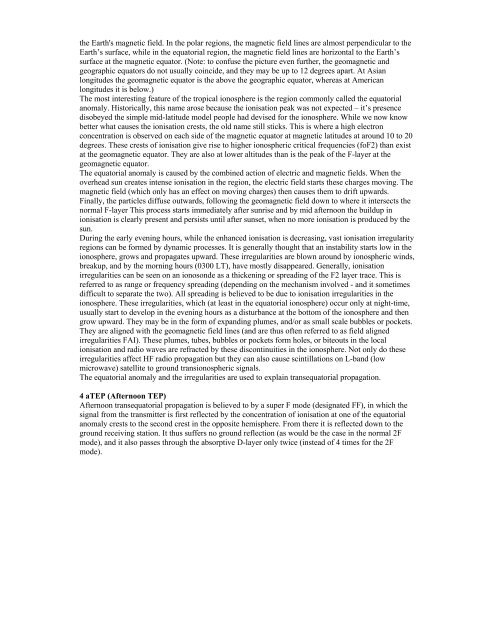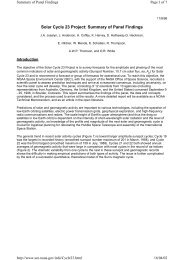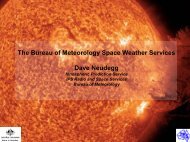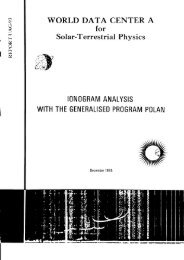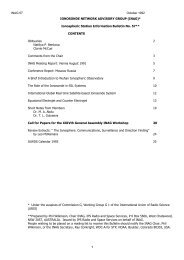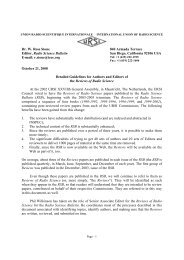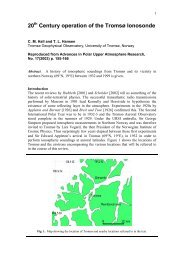Transequatorial Radio Propagation - IPS - Radio and Space Services
Transequatorial Radio Propagation - IPS - Radio and Space Services
Transequatorial Radio Propagation - IPS - Radio and Space Services
You also want an ePaper? Increase the reach of your titles
YUMPU automatically turns print PDFs into web optimized ePapers that Google loves.
the Earth's magnetic field. In the polar regions, the magnetic field lines are almost perpendicular to the<br />
Earth’s surface, while in the equatorial region, the magnetic field lines are horizontal to the Earth’s<br />
surface at the magnetic equator. (Note: to confuse the picture even further, the geomagnetic <strong>and</strong><br />
geographic equators do not usually coincide, <strong>and</strong> they may be up to 12 degrees apart. At Asian<br />
longitudes the geomagnetic equator is the above the geographic equator, whereas at American<br />
longitudes it is below.)<br />
The most interesting feature of the tropical ionosphere is the region commonly called the equatorial<br />
anomaly. Historically, this name arose because the ionisation peak was not expected – it’s presence<br />
disobeyed the simple mid-latitude model people had devised for the ionosphere. While we now know<br />
better what causes the ionisation crests, the old name still sticks. This is where a high electron<br />
concentration is observed on each side of the magnetic equator at magnetic latitudes at around 10 to 20<br />
degrees. These crests of ionisation give rise to higher ionospheric critical frequencies (foF2) than exist<br />
at the geomagnetic equator. They are also at lower altitudes than is the peak of the F-layer at the<br />
geomagnetic equator.<br />
The equatorial anomaly is caused by the combined action of electric <strong>and</strong> magnetic fields. When the<br />
overhead sun creates intense ionisation in the region, the electric field starts these charges moving. The<br />
magnetic field (which only has an effect on moving charges) then causes them to drift upwards.<br />
Finally, the particles diffuse outwards, following the geomagnetic field down to where it intersects the<br />
normal F-layer This process starts immediately after sunrise <strong>and</strong> by mid afternoon the buildup in<br />
ionisation is clearly present <strong>and</strong> persists until after sunset, when no more ionisation is produced by the<br />
sun.<br />
During the early evening hours, while the enhanced ionisation is decreasing, vast ionisation irregularity<br />
regions can be formed by dynamic processes. It is generally thought that an instability starts low in the<br />
ionosphere, grows <strong>and</strong> propagates upward. These irregularities are blown around by ionospheric winds,<br />
breakup, <strong>and</strong> by the morning hours (0300 LT), have mostly disappeared. Generally, ionisation<br />
irregularities can be seen on an ionosonde as a thickening or spreading of the F2 layer trace. This is<br />
referred to as range or frequency spreading (depending on the mechanism involved - <strong>and</strong> it sometimes<br />
difficult to separate the two). All spreading is believed to be due to ionisation irregularities in the<br />
ionosphere. These irregularities, which (at least in the equatorial ionosphere) occur only at night-time,<br />
usually start to develop in the evening hours as a disturbance at the bottom of the ionosphere <strong>and</strong> then<br />
grow upward. They may be in the form of exp<strong>and</strong>ing plumes, <strong>and</strong>/or as small scale bubbles or pockets.<br />
They are aligned with the geomagnetic field lines (<strong>and</strong> are thus often referred to as field aligned<br />
irregularities FAI). These plumes, tubes, bubbles or pockets form holes, or biteouts in the local<br />
ionisation <strong>and</strong> radio waves are refracted by these discontinuities in the ionosphere. Not only do these<br />
irregularities affect HF radio propagation but they can also cause scintillations on L-b<strong>and</strong> (low<br />
microwave) satellite to ground transionospheric signals.<br />
The equatorial anomaly <strong>and</strong> the irregularities are used to explain transequatorial propagation.<br />
4 aTEP (Afternoon TEP)<br />
Afternoon transequatorial propagation is believed to by a super F mode (designated FF), in which the<br />
signal from the transmitter is first reflected by the concentration of ionisation at one of the equatorial<br />
anomaly crests to the second crest in the opposite hemisphere. From there it is reflected down to the<br />
ground receiving station. It thus suffers no ground reflection (as would be the case in the normal 2F<br />
mode), <strong>and</strong> it also passes through the absorptive D-layer only twice (instead of 4 times for the 2F<br />
mode).


